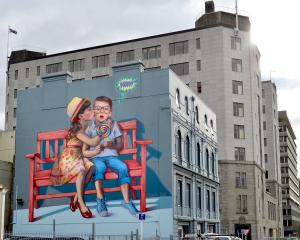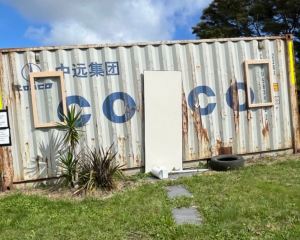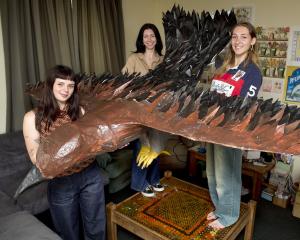Bill Culbert and the late Ralph Hotere first met in London in the 1970s and became close friends, even though they lived on opposite sides of the world. Culbert, born in Port Chalmers, lived and worked in London and southern France, while Hotere, born in the far north of New Zealand, lived and worked in Port Chalmers.
''Ralph came to France a lot and stayed with us. When he was painting in Avignon I was in his studio in Port Chalmers,'' Culbert said.
The artist is in Dunedin to help set up ''Hotere Culbert'', an exhibition of some of their major collaborative works, Pathway to the Sea, P.R.O.P., and Blackwater. It opens at the Dunedin Public Art Gallery at the weekend.
It would be impossible to bring to Dunedin their other two major collaborative works, Fault (1994), and their last piece together, Void (2006), gallery curator Aaron Kreisler said. The former is permanently installed at City Gallery Wellington and the latter at Te Papa.
In the late 1970s, Hotere and Culbert's first collaborative work, Avignon Crate, included a crate Hotere had built to transport his canvases home, and fluorescent tubes, and was shown only briefly in a London gallery.
''Some fireman or inspector came in and said it couldn't be shown because of the risk, so it was taken out,'' Culbert says.
Culbert's works, which often include lit fluorescent tubes and other lights, are usually reworked when shown in different galleries to meet electrical regulations and other safety requirements.
''They are electrically safe but if someone runs through something - children are very dodgy sometimes,'' he says.
The two artists were serious about art from the beginning of their collaboration.
''We were pleased to see each other, to know each other, and formulated a pretty silent but considerable exchange of things. Most of the work we did was quite specifically for a place or a reason,'' Culbert says.
Their first major work , Pathway to the Sea - Aramoana, shown in the Auckland Art Gallery in 1991, generated considerable interest.
At the time, Port Otago was proposing to demolish Observation Point, home to Hotere's studio, to make way for log storage at Port Chalmers.
''As I was from Port Chalmers, it was my home, so when it was going on Ralph and I had some talks about it. We were pretty concerned about the whole logging thing, of not considering the people. If you lived there it was savage, those trucks coming through the town.''
They built P.R.O.P. [Preserve Observation Point] in protest. It was first shown at the RKS Gallery in Auckland, then at the ''Headlands'' exhibition in the Museum of Contemporary Art in Sydney.
Later, while Culbert was working at Piha, south of Auckland, he was visited by René Block, a German curator who was organising ''Toi, Toi, Toi'', an exhibition of New Zealand works, for the Museum Fridericianum in Kassel, Germany, in 1999. He asked if Culbert and Hotere would be interested in working on a piece for it.
Born in 1935, Culbert left New Zealand aged 23 to study in London on a National Art Gallery scholarship. He says he didn't actually decide to stay in Europe, but he met his wife Pip, also an artist, and they had children so it became impossible to move as they didn't have the money. They had a place in southern France which was cheaper to buy than rent and they ended up living there part of the time, he says.
London offered many opportunities and was a fantastic place to live and be part of in the 1960s. Artists were working together to put on exhibitions instead of relying on galleries.
Living and working there was exciting but wasn't easy. He could have come home and returned to teaching. Many other New Zealanders were returning because of the threat of nuclear war and New Zealand seemed a safer place. Working as a painter in the 1960s, he became particularly interested in light.
''All the colours are in light and when it's broken up into the spectrum you get rainbows. The other nice thing, if you make a hole, light will go through. Light travels. It's super; it's very surprising, but light itself is often not even taken into consideration.
''I attempted to work with light: I'd always been photographing anyway. The first objects I made were basically with light bulbs and the light from reflection and shadow. It became increasingly adventurous to make installations about light where light was able to become the question, not necessarily the answer to anything,'' he says.
''At that point one was suddenly liberated from working on a surface, from working on a wall or on paper or canvases - not that that was problematic. I didn't stop making drawings because drawings were a way of explaining to yourself what you were thinking. You'll see in this exhibition quite a lot of drawings. When Ralph and I were discussing we'd make them but although they were very simple, they contained all the information we needed to make the works.''
In art, as in many other things, you have to do it in order to know where you are going, he says.
Although now in his late 70s, Culbert represented New Zealand at the Venice Biennale this year, making several major new works.
Kreisler says it's an indication of how he's seen internationally.
''There are thousands of people each day going through a contemporary art project made by a New Zealander in his late 70s, surrounded by kids and what's hot and what's not.''
In Colbert's collaborations with Hotere there was a sense of singularity, a frisson of ideas and a confidence of what each brought to the project. Unlike some other collaborative works you get a recognition of each other which you see in the drawings, Kreisler says.
''I think there is this interesting thing where it melds their individual practices in a way which is truly like looking at a singular.''
See it
Hotere Culbert is on at the Dunedin Public Art Gallery from October 12 to March 9.












